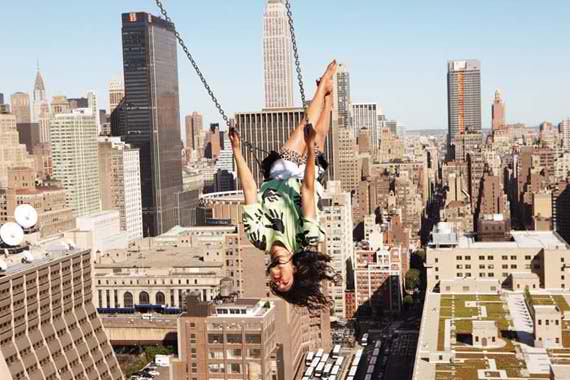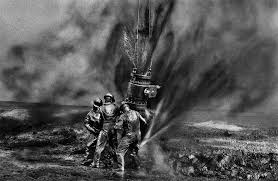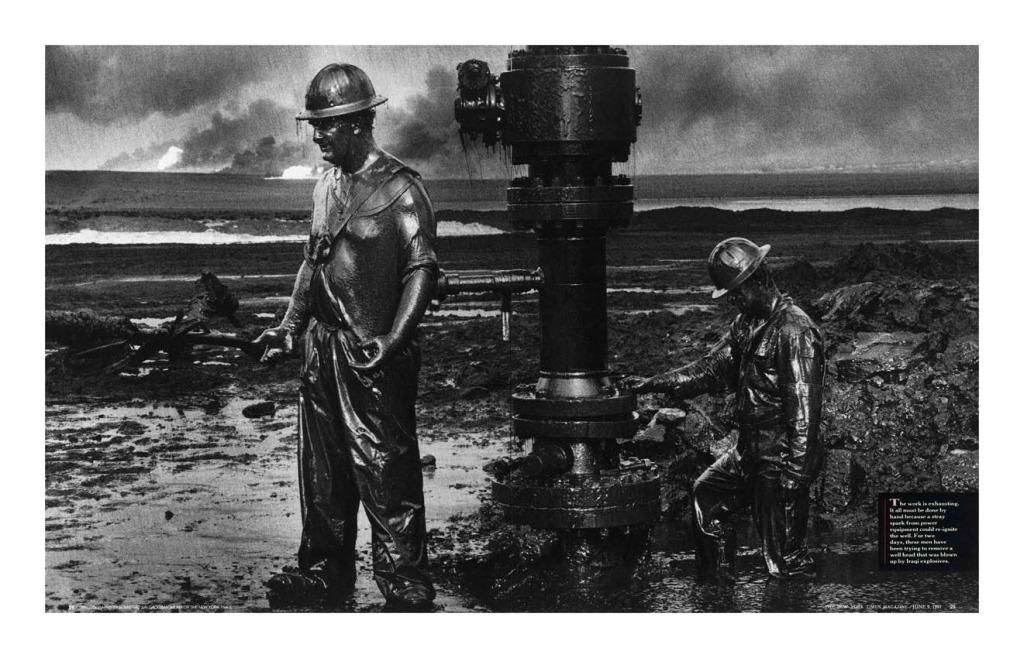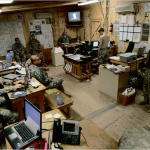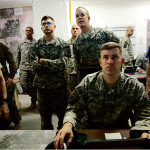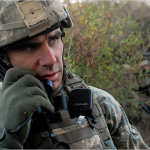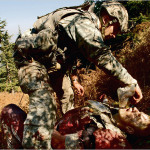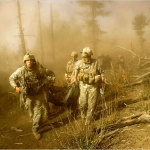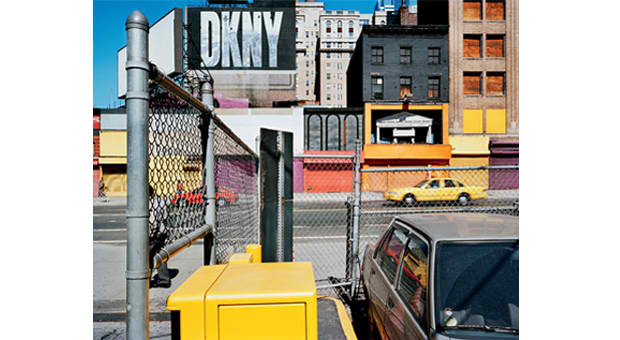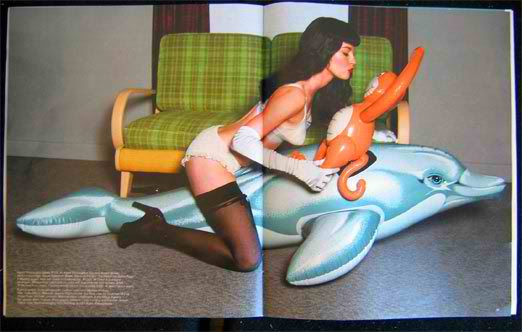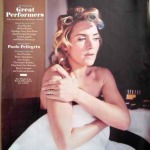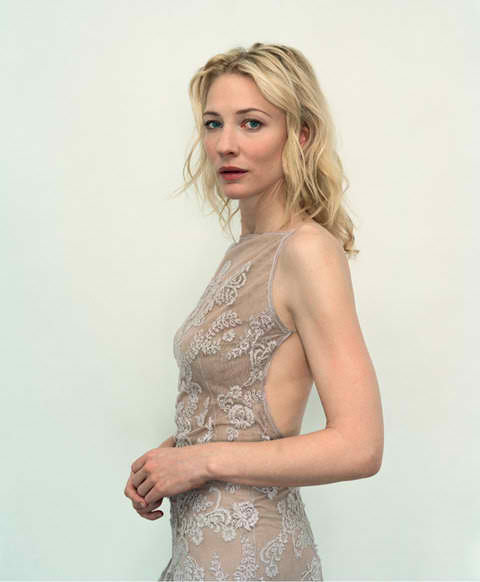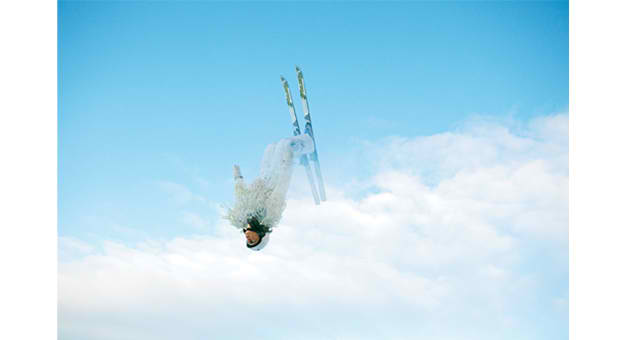“New York Times Photographs,” opened at The Hunter Museum of American Art in Chattanooga, TN on November 28, 2014 and runs through March 22, 2015. A shorter version of this article appeared as the cover story in The Chattanooga Pulse, December 4, 2014.
“New York Times Magazine Photographs”, appearing at the Hunter Museum of American Art in Chattanooga, engages the viewer with images of startling power and originality. Curated by New York Times photo editor Kathy Ryan and organized by Aperture Foundation’s Lesley A. Martin, this exhibition explores work published by the magazine during the last fifteen years. Over 100 photos taken by 35 photographers are organized into thirteen sections that reveal the surprising range of creative expression possible with the camera. The finest photographers from around the world explore subjects as diverse as the humanitarian crisis in Darfur, the world of high fashion, the Olympics, the war in Iraq, and celebrity portraiture. Their photo-essays invariably display the New York Times Magazine’s willingness to push beyond convention and seek a fresh viewpoint.
“To me, the process where a photographer visualizes a subject and the creative way a painter reimagines a subject just aren’t all that different. I don’t see them as two separate things.”
–Hunter Museum chief curator, Nandini Makrandi.
Thanks to the creativity of the photographers, the camera’s expressive potential is readily apparent. However, if the photography of these modern masters is individual in its vision, photojournalism itself is a corporate process. A unique feature of this exhibition is the way it documents how the photo-essays seen in the Magazine come into being, how photographers are chosen for assignments, and how, through careful selection and thoughtful presentation, a visual story is honed by the Magazine editors. We see not only published photos, but also the many that did not make the editorial cut. Tearsheets show how the photos that ran in the Magazine actually looked in print. As Nandini Makrandi points out, “Normally those editorial decisions are hidden, but in this exhibit they are brought out for the viewer’s consideration.”
An examination of some of the photographs in the exhibition will serve to illustrate how the willingness of the Magazine’s editor to take chances often results in images that are unforgettable.
For over forty years, the legendary Brazilian photographer and environmentalist, Sebastiao Salgado, has documented the lives of people all over the world with powerful black and white images. In 1991, with the U.S. and its allies about to invade Kuwait, he anticipated events, calling Kathy Ryan the day the war began to ask if he could document the environmental devastation he was sure would occur. Hurrying to the Mideast, he waited on the Kuwaiti border, as the New York Times frantically pressed authorities to allow him access to the oil fields. Days later he witnessed an inferno—over 100 oil wells in flames and workers struggling heroically to stem the disaster.
Salgado’s black and white photos are elemental in their grim power, expressing the desperate struggle of exhausted men taming the damaged wells. The classical visual compositions stand in striking juxtaposition with the battle being waged against the forces of chaos. Salgado presents us with a visual depiction of the ancient epic of human struggle against a hostile world, but sadly, he depicts a world made hostile by the madness of humans. It is a current event the photographer has raised to mythic status.
The photo-essay exploring and explaining current events has been a staple of the genre from its inception. The New York Times Magazine excels in this such long form reportage. For instance, in 2007 the magazine sent photographer Lynsey Addario and writer Elizabeth Rubin to the Afghanistan, embedded with the U.S. Army’s Battle Company of the 173 Airborne Brigade. The Battle Company soon became engaged in a 6 day mission to control Korengal Valley before the onset of winter.
- Capt. Dan Kearney left foreground with members of his unit at the Korengal Outpost command center in northeastern Afghanista
- Eyes in the Sky At Camp Blessing battalion members — led by Lt. Col. Bill Ostlund far right — watch a monitor showing Capt. Dan Kearney’s troops six miles away.
- In the Valley– Capt. Dan Kearney.
- Sgt. Tanner Stichter tends to a wounded Specialist Carl Vanderberge.
- Hostile Fire U.S. troops carry the body of Staff Sgt. Larry Rougle who was killed when the insurgents ambushed their squad in the Korengal Valley
- Elders in a village after it was bombed.
Throughout the mission, which became a running battle with the Taliban, these courageous journalists documented the destruction and suffering they witnessed. Addario photographed these grim and desperate moments in color and at close range, giving her images the look of snapshots. It’s a quality that conveys a sense of intimacy and immediacy–the sense that events are unfolding in real lives even as we read. Such an unblinking look at the specific moment raises her work toward the universal. These two veteran journalists, a writer and photographer, address in their work the humanity of all the participants: the warriors who fight and die as well as the civilians who suffer beside them.
In 1997, for a very different project, “Assignment: Times Square”, the magazine assembled a roster of 16 photographers, each of who could bring a very different eye and sensibility to the story. At that time, the Times Square neighborhood was on the edge of a complete transformation from its seedy past, and the editors wanted to capture a sense of the storied place. The resulting photo shoot produced an astonishing variety of images: city streets, buildings, portraits, and genre scenes. Swedish photographer Lars Tunbjork’s photo of the buildings at the corner of 8th Avenue and 42nd Street is timeless. “Forty-Second Street at the time was a strange place,” writes Tunbjork, “with all the abandoned cinemas and porno palaces—like a big empty theater set. I took this picture on a sunny Sunday. I love sunny Sundays in New York; the air is clean, and the light is so crisp and hard. I thought of the paintings of Piet Mondrian when I saw these buildings and the strong colors.”
In addition to giving considerable creative control to its photographers, the New York Times Magazine’s Kathy Ryan also likes to do ‘cross-over’ assignments, asking photographers known for their deft handling of one subject to photograph something different. An example is shown in the assignment given to Roger Ballen. Known for his dramatic and disturbing surreal images, Kathy Ryan chose him as a photographer for a fashion shoot. Ballen worked with actress Selma Blair to produce, “The Selma Blair Witch Project: Fall’s Dark Silhouette has a Way of Creeping Up on You.” The photograph, “Resemblance”, at once creepy and funny, has Blair, dressed in designer clothing, inhabiting an image both enigmatic and psychologically charged. It is an revealing rumination on the nature of fashion. Stripped of its special environment of runways, supermodels, and fashion journalists, the designer clothes wilt and become rather ordinary in the utterly bizarre settings that Ballen conjures up. Not surprisingly, Ballen noted, “I won an award for that fashion shoot but no one has asked me to do another one.”
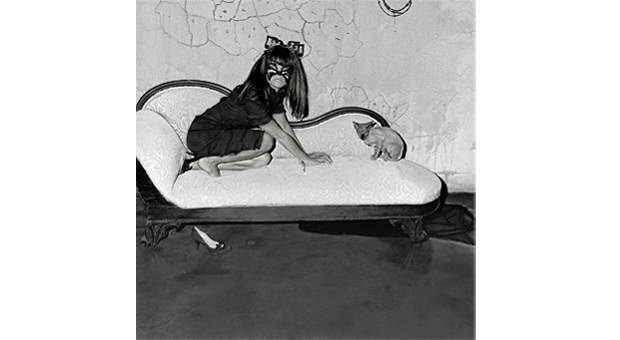
Roger Ballen, Actress Selma Blair. From “The Selma Blair Witch Project– Fall’s Dark Silhouettes Have a Way of Creeping Up on You,” 2005
In yet another example of the Magazine’s creative thinking, assignments sometimes go to artists who are not photographers. Artist Chuck Close’s photos appear in ‘Assignment: Times Square’ and Jeff Koons, a sculptor, worked with actress Gretchen Mol to recreate Bettie Page images from the 1940s and 50s in which sexual fetish imagery is presented in vivid color and filtered through Koons’s tongue-in-cheek humor.
“When you’re looking at a Jeff Koons photograph,” says Nandini Makrandi, “you’re not necessarily looking for him to be a technically excellent photographer. The interest is in how he translates the vision he is known for into the medium of photography? Is his puckish sensibility and his sense of humor present in his images?” Koons presents the viewer with photographs in which eroticism blends into absurdity. The eye is caught by the garish color and provacative poses, only to have the response end in bemused laughter.
Why not send a veteran war photographer to photograph the Oscar-worthy actors one year? Or commission a gallery of Olympians by an artist with a very personal iconography, rather than by a sports photographer?
–New York Times Magazine photo editor, Kathy Ryan
- Paolo Pelegrin– The Exodus
- Paolo Pelegrin– Cate Blanchette
Paolo Pelegrin’s work would hardly be called puckish. The exhibition contains three photo-essays that Pelegrin has done for New York Times Magazine over the last fifteen years. We see his photography move from film to digital, but always his work has what Kathy Ryan has called “a poetic sensibility.” In his 2002 essay, “An Impossible Occupation,” he tells the story of a platoon of Israeli soldiers on duty in Palestinian territory. His 2004 photos in “How Did Darfur Happen?” explored a humanitarian crisis. “The Exodus” from 2009, documents the flight of Libyans across the border into Tunisia and displays his ability to deal with large events in terms that are both immediate and empathetic.
However, true to her inclination to offer photographer cross-over assignments, Ryan asked Pelegrin to photograph Hollywood celebrities for the magazine’s article on in the the yearly run up to the Oscars. Pelegrin’s images are not what a viewer has grown used to in such stories. They portray the famous in mundane moments. And taking it even farther, he often imposes jarring compositions on his images or skewed camera angles. They are visual devices that draw attention to the artifice of the celebrity life by isolating moments when artifice has failed. No words can explain this approach better than simply comparing the photos of Cate Blanchette by Pelegrin and Rincke Dijkstra. If Dijkstra’s image gives us a sense of the fragility of the celebrity’s world, Pelegrin shows us the unflattering private preparation that must precede the public moment.
The brilliant young photographer, Ryan McGinley, had previously worked with subjects such as skateboarders, musicians, and graffiti artists. His assignment to photograph Olympians was a challenge to transcend the banal. His talent combined with the resources provided by Kathy Ryan created images of lasting beauty.
“One of the fun examples of cross-assigning can be found in the Olympic portfolios Ryan McGinley has done.”
–New York Times Magazine photo editor, Kathy Ryan
The Magazine contracted with the design team of Rodarte to provide special outfits for the athletes. McGinley came up with unique camera angles and compositions. Thousands of photographs were taken, and a visual story evolved that goes far beyond appearances to reveal the very essence of what these uniquely trained people are. In his incredible photo of the free-style skier, Emily Cook, McGinley captures a moment in the performance of a sport that routinely sends skiers soaring into the sky; so Emily Cook is shot against the sky, soaring into the sky, becoming the sky. She defies physical laws, hovering as an ethereal being above the common world below. It is a visual manifestation of how she feels at that very second. It is a glorious moment in the art of the camera.
Copyright 2014 James Tucker
Return to Artists and Their Art
